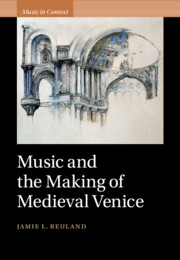Book contents
- Music and the Making of Medieval Venice
- Music in Context
- Music and the Making of Medieval Venice
- Copyright page
- Dedication
- Contents
- Figures
- Maps
- Tables
- Music Examples
- Acknowledgments
- Manuscript Sigla
- A Note on Dating
- Abbreviations
- Introduction
- Part I An Audible Empire
- Part II The Fictive City
- Part III Relics and the Horizons of Musical Representation
- 4 Narrative Fragments
- 5 History Lessons
- 6 Sound Documents
- Epilogue
- Book part
- Bibliography
- Index
6 - Sound Documents
The Midcentury Chancery Motet
from Part III - Relics and the Horizons of Musical Representation
Published online by Cambridge University Press: 12 October 2023
- Music and the Making of Medieval Venice
- Music in Context
- Music and the Making of Medieval Venice
- Copyright page
- Dedication
- Contents
- Figures
- Maps
- Tables
- Music Examples
- Acknowledgments
- Manuscript Sigla
- A Note on Dating
- Abbreviations
- Introduction
- Part I An Audible Empire
- Part II The Fictive City
- Part III Relics and the Horizons of Musical Representation
- 4 Narrative Fragments
- 5 History Lessons
- 6 Sound Documents
- Epilogue
- Book part
- Bibliography
- Index
Summary
Chapter 6 considers the two earliest motets known to have been composed for Venetian ceremony: Ave corpus sanctum gloriosi Stefani (1329–39) and Marce, Marcum imitaris (ca. 1365), both anonymous. Situating these works within Andrea Dandolo’s midcentury chancery, this chapter argues for music’s embeddedness in the chancery’s most significant historiographical enterprises. I show how the same chancellors and scribes who copied and organized legal and diplomatic texts oversaw the production of historiographic, literary, and musical works as well. As readings of these motets bear out, the collapsing of chancery functions had aesthetic consequences; the rhetoric on display in both works straddles the humanist–conservatist divide for which the chancery—the engine of Venetian historiography—was known. My readings of Ave corpus sanctum and Marce, Marcum imitaris reveal them working in tandem with the chancery’s most significant historiographical enterprises. Not only do they bear strong thematic links to the topics most heavily elaborated within the midcentury chancery, but they exemplify an approach to history that matched the explicit charge of the chancery: to make the state sensible through the organization of its sundry items and documents.
- Type
- Chapter
- Information
- Music and the Making of Medieval Venice , pp. 191 - 229Publisher: Cambridge University PressPrint publication year: 2023

